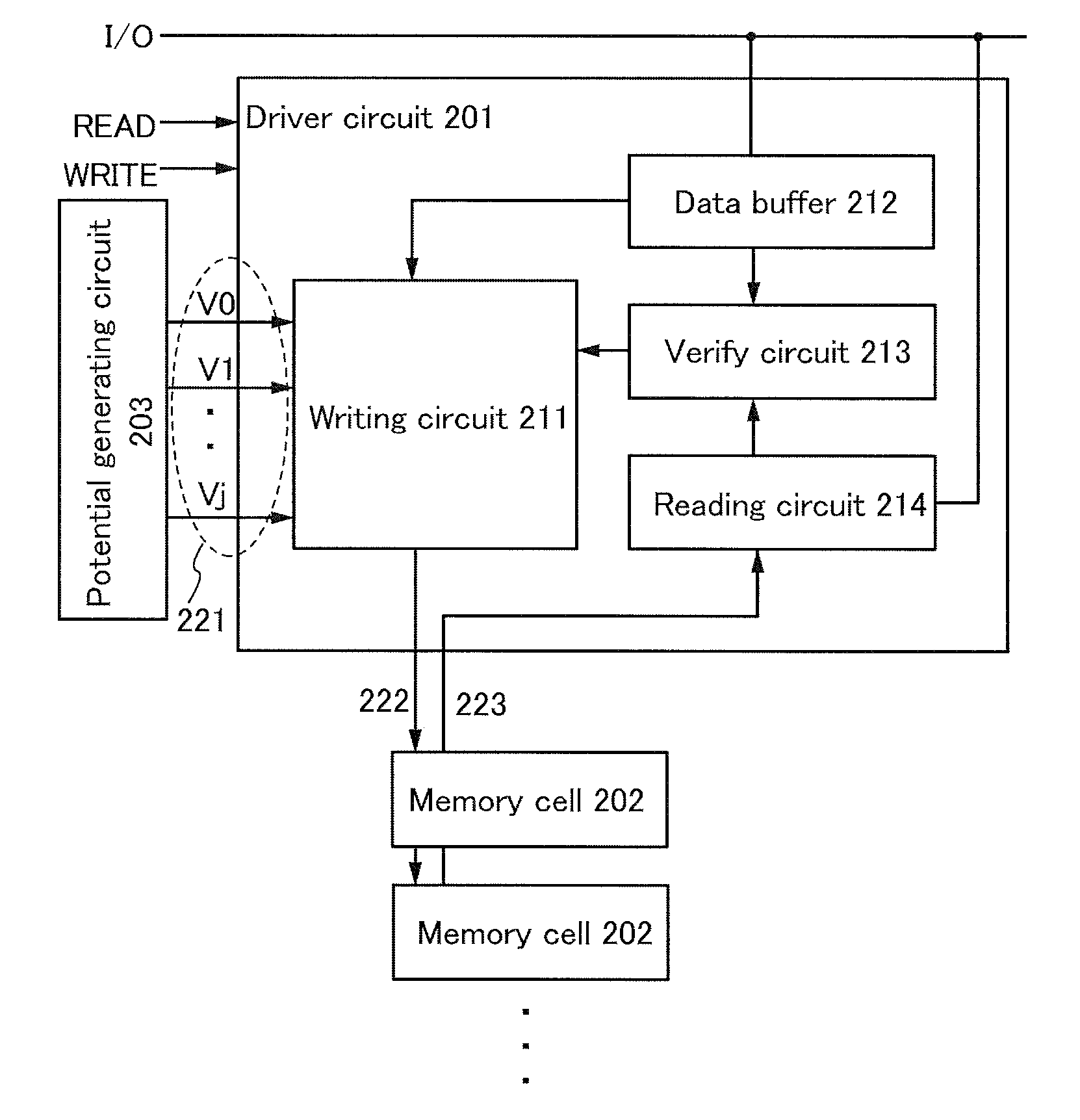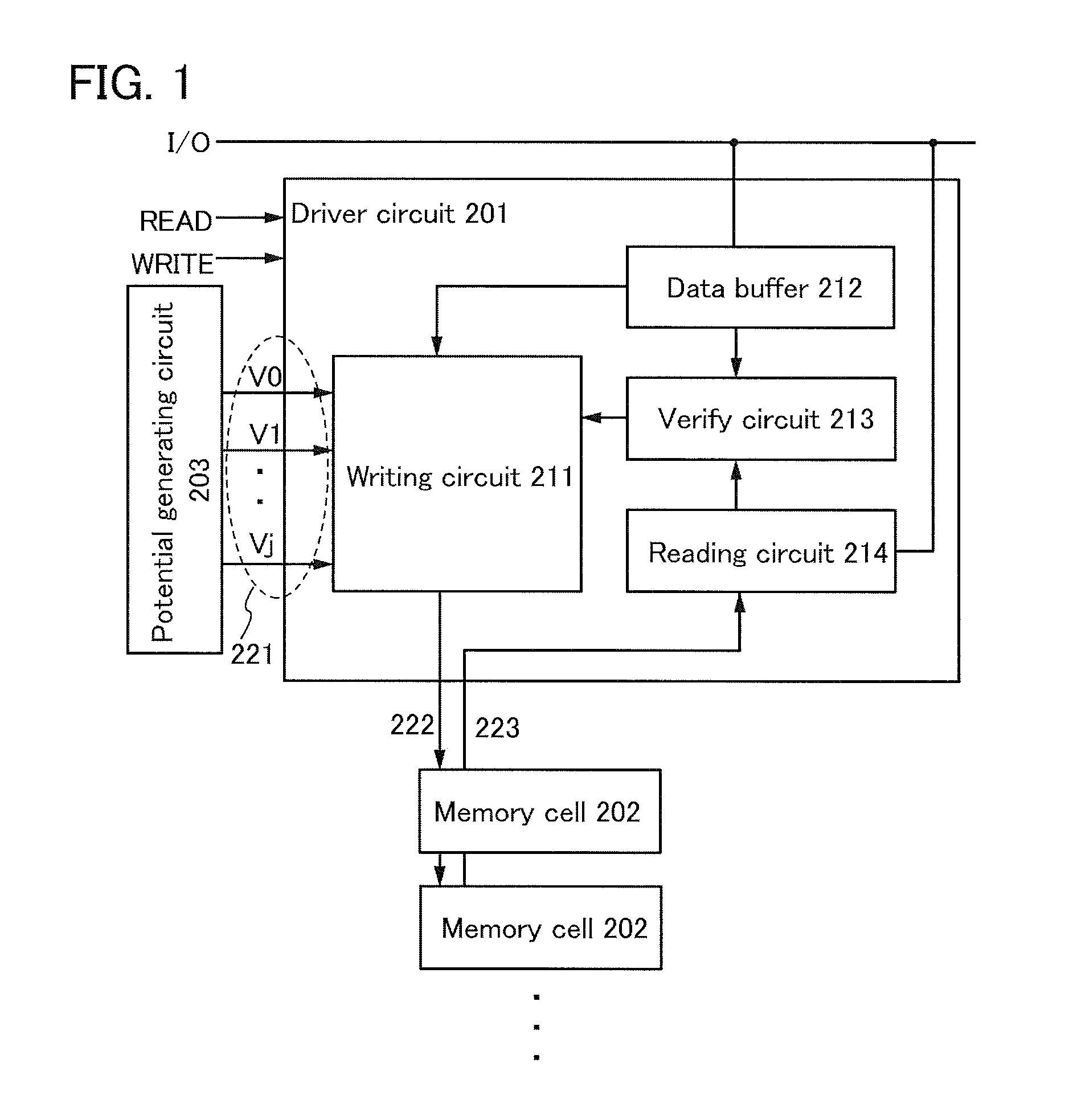Semiconductor device and method for driving semiconductor device
a semiconductor device and semiconductor technology, applied in the field of semiconductor devices, can solve the problems of limited reduction of the operation voltage of the memory cell, fluctuation of the potential needed for driving a plurality of memory cells, and operation errors, so as to achieve the effect of reducing the frequency of refresh operation, storing data for an extremely long time, and reducing power consumption
- Summary
- Abstract
- Description
- Claims
- Application Information
AI Technical Summary
Benefits of technology
Problems solved by technology
Method used
Image
Examples
embodiment 1
[0091]In this embodiment, a structure and operation of a semiconductor device according to one embodiment of the disclosed invention will be described with reference to FIG. 1, FIGS. 2A to 2D, FIGS. 3A to 3D, and FIGS. 4A and 4B.
[0092]FIG. 1 is an example of a block diagram of a semiconductor device including memory cells.
[0093]The semiconductor device includes a plurality of memory cells 202, a driver circuit 201, and a potential generating circuit 203. The driver circuit 201 includes a data buffer 212, a writing circuit 211, a reading circuit 214, and a verifying circuit 213. Each of the plurality of memory cells 202 includes a transistor (not shown) including an oxide semiconductor and a transistor (not shown) including a material other than an oxide semiconductor. Further, the semiconductor device includes a wiring for supplying an input / output signal (I / O) (also referred to as a data input / output line), a wiring for supplying a read signal (READ), and a wiring for supplying a w...
embodiment 2
[0146]In this embodiment, a circuit configuration and operation of a memory cell included in a semiconductor device according to one embodiment of the disclosed invention will be described with reference to FIGS. 5A1, 5A2, and 5B. Note that in some circuit diagrams, “OS” is written beside a transistor in order to indicate that the transistor includes an oxide semiconductor.
[0147]In a memory cell illustrated in FIG. 5A-1, a first wiring (a 1st Line) and a source electrode (or a drain electrode) of a transistor 160 are electrically connected to each other, and a second wiring (a 2nd Line) and the drain electrode (or the source electrode) of the transistor 160 are electrically connected to each other. In addition, a third wiring (a 3rd Line) and a source electrode (or a drain electrode) of a transistor 162 are electrically connected to each other, and a fourth wiring (a 4th Line) and a gate electrode of the transistor 162 are electrically connected to each other. Further, a gate electr...
embodiment 3
[0182]In this embodiment, application examples of a semiconductor device according to one embodiment of the disclosed invention will be described with reference to FIGS. 6A to 6C. Here, examples of a memory device will be described. Note that in some circuit diagrams, “OS” is written beside a transistor in order to indicate that the transistor includes an oxide semiconductor.
[0183]FIGS. 6A to 6C are each a circuit diagram of a semiconductor device, which can be used as a memory device, including a plurality of semiconductor devices (hereinafter also referred to as memory cells) illustrated in FIG. 5A1. FIGS. 6A and 6B are circuit diagrams of so-called NAND semiconductor devices in which memory cells are connected in series, and FIG. 6C is a circuit diagram of a so-called NOR semiconductor device in which memory cells are connected in parallel.
[0184]The semiconductor device in FIG. 6A includes a source line SL, a bit line BL, a first signal line S1, m second signal lines S2, m word l...
PUM
| Property | Measurement | Unit |
|---|---|---|
| energy gap Eg | aaaaa | aaaaa |
| temperature | aaaaa | aaaaa |
| off-state current | aaaaa | aaaaa |
Abstract
Description
Claims
Application Information
 Login to View More
Login to View More - R&D
- Intellectual Property
- Life Sciences
- Materials
- Tech Scout
- Unparalleled Data Quality
- Higher Quality Content
- 60% Fewer Hallucinations
Browse by: Latest US Patents, China's latest patents, Technical Efficacy Thesaurus, Application Domain, Technology Topic, Popular Technical Reports.
© 2025 PatSnap. All rights reserved.Legal|Privacy policy|Modern Slavery Act Transparency Statement|Sitemap|About US| Contact US: help@patsnap.com



